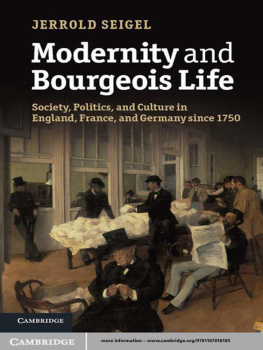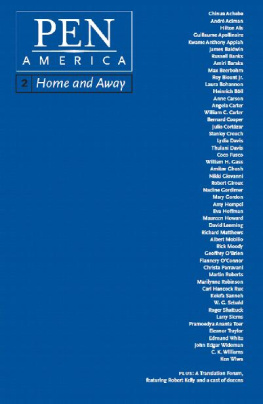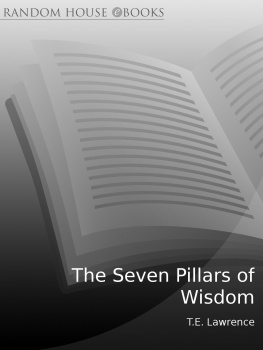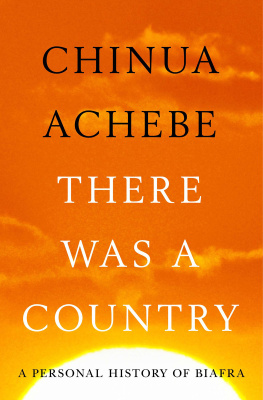Copyright 2016 University of Pennsylvania Press
All rights reserved. Except for brief quotations used for purposes of review or scholarly citation, none of this book may be reproduced in any form by any means without written permission from the publisher.
Published by
University of Pennsylvania Press
Philadelphia, Pennsylvania 19104-4112
www.upenn.edu/pennpress
Printed in the United States of America
on acid-free paper
10 9 8 7 6 5 4 3 2 1
Library of Congress Cataloging-in-Publication Data
Seigel, Jerrold E., author.
Between cultures: Europe and its others in five exemplary lives / Jerrold Seigel.
pages cm. (Intellectual history of the modern age)
Includes bibliographical references and index.
ISBN 978-0-8122-4761-9 (alk. paper)
1. East and West. 2. East and West in literature. 3. Transnationalism. 4. Identity (Psychology). 5. CulturePsychological aspects. 6. Burton, Richard Francis, Sir, 18211890. 7. Lawrence, T. E. (Thomas Edward), 18881935. 8. Massignon, Louis, 18831962. 9. Achebe, Chinua. 10. Pamuk, Orhan, 1952 I. Title. II. Series: Intellectual history of the modern age.
CB251.S426 2016
909.09821dc23
2015006914
Introduction
Early in September 1853, Richard Burton arrived in Mecca. Part of a caravan of Muslim pilgrims, Burton was clothed much like his companions and, like them, recited the appropriate prayers, in good Arabic, as he approached each of the storied and sacred sites. But Burton was an Englishman in disguise, a captain in the British army who had begun his study of Arabic at Oxford and tried out his ability to present himself as an Oriental while serving in India during the 1840s; he would spend most of his career as a British civil servant and diplomat, while writing many books. In 1855 he told the world about his trip in a Personal Narrative of a Pilgrimage to Al-Medinah and Meccah, the work that made his reputation as the colorful, adventurous, challenging, and to some people suspicious and problematic figure he would remain until his death in 1890. By then he would be known at once for his far-ranging travels, his deep involvement in Eastern culture, and for his assertive skepticism toward both religion and established morality.
Interest in Burtons life and writings has been inspired by many things: the rare mix of adventurousness and intellect that made him at once one of the preeminent explorers of his day and a writer of astounding range and erudition; his ability both to represent the Victorian age to which he belonged and to challenge its pieties; his mix of loyalty to the British Empire and the values it claimed to foster with a radicalism that undermined them. But what best joins these strands of his persona together is a thread his pilgrimage to Mecca strongly highlights, especially since, as we will see, he was moved by a genuine fascination and respect for Arab life and religion: he sometimes sought to inhabit more than one culture at the same time. In these moments he dedicated himself to opening up a real or imagined space between cultures, where he could infuse the persona formed in one with qualities and energies drawn from another.
Individuals in all these situations may feel a need to navigate between cultures, to cross cultural boundaries while somehow acknowledging or preserving them. But immigrants are principally engaged in passing from one cultural environment to another (although the transition may stretch out over generations), a situation to which certain advocates of multiculturalism today respond with defensive strategies for preserving group identities against forces that threaten to dilute them. Neither substituting one group identity for another nor circling the wagons around an identity considered to be endangered generates what the figures represented in this book attempted: to explore the lineaments and horizons of an intercultural space while residing within it. At times some sought to protect one way of life against another, but even in doing so they were preoccupied with the challenge of taking on a second cultural identity as part of their way of inhabiting their first. Each created a kind of dialogue between two personae within a single self.
Alongside Burton, the people whose lives and careers we take up below are T. E. Lawrence (celebrated as Lawrence of Arabia), Louis Massignon (a renowned, deeply introspective, and profoundly troubled French scholar of Islam), Chinua Achebe (a major pioneer in modern African literature), and Orhan Pamuk (the Nobel Prizewinning Turkish novelist). A few others appear more briefly, in particular two African writers with ties to Achebe, Sheikh Hamidou Kane and Tayeb Salih. I will say more about why I have chosen them in a moment, but two things they all have in common need to be noted at the start. One is the high degree of self-awareness already mentioned: all of them gave special and sustained attention to assessing the benefits and dangers of intercultural existence. The second is that each sought to bridge some explicitly European identity with a persona rooted That some of our subjects did this from a European starting point and others from one rooted elsewhere created sharp contrasts between them, especially because all of them understood the deep harms visited on other peoples by European colonialism. Such differences are of great import, to be sure, but we will see that they did not blot out the common elements and issues all of them confronted in attempting to live between cultures.
Let it be clearly noted at the start that such a way of being is by no means always a happy one. There can be something disorienting, even threatening, about inhabiting two different and sometimes hostile worlds at the same time, and it may well be impossible to carry out in a satisfying way; to some degree all the figures we consider failed in the attempt or chronicled the failures of others. But even when the failure brought pain and regret, and perhaps especially then (most deeply in the case of Lawrence), there was and remains something exemplary about the lives and histories they fashioned as a result. I hope the chapters that follow will show that this project of simultaneously cultivating identities rooted in different cultures, notably in Western and Eastern (or at least non-Western) cultures, raises large and important questions, involving not just the specific relations between Europe and other regions of the world, but also what it means for human beings to be cultural beings, both creatures and creators of cultures.
* * *
I think it will be helpful to give some sense of what these questions involve at the start, by thinking for a moment about the capacities human beings must possess in order to live as cultural beings. For this there can be no better point of entry than language, probably the greatest gift human cultures bestow on their members. The benefits of language are legion: other creatures communicate in various ways, but human speech and writing provide vehicles for exchanging information that are at once far more stable and precise, and more general and flexible, than what other living beings possess. Language is, in Steven Pinkers phrase, the stuff of thought, but it is also a tool for conveying and refining feelings, allowing people to exercise and cultivate both intellectual and affective capacities that would remain undeveloped without it. It also provides human groups with a chief medium of collective memory, making real or fictional accounts of past experience available to successive generations and offering rich resources for individual and communal nurture, albeit ones that are not always employed in beneficial ways.










